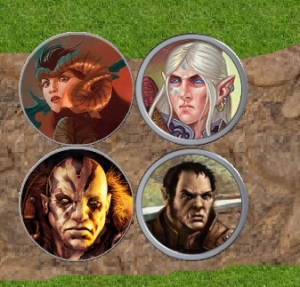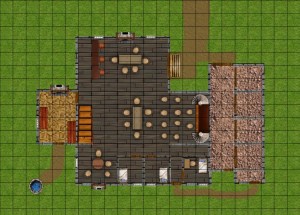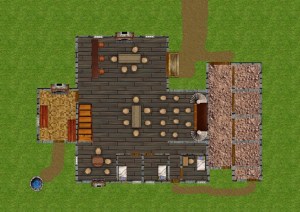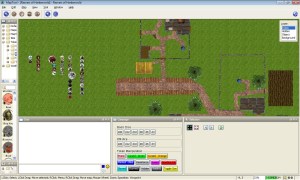I’ve finished reading through the bulk of the Pathfinder Core Rulebook in preparation for the campaign in which I will soon be a player, and I thought I’d share my thoughts here. My background with RPGs is:
- I played a little bit of D&D 3.0 around 2002. I got the core books, read them, loved them, played a session or two, wrote an adventure, never found a good group to play with, drifted away.
- I started playing D&D 4e in early 2010, and here I am now. I’ve played and DMed a ton of 4e over the past year and a half.
- In that year and a half, I’ve also had the chance to play one session each of AD&D 1e, GURPS, Savage Worlds and Call of Cthulhu.
So, I’m approaching Pathfinder as an experienced D&D 4e player, with some exposure to other games, including earlier editions of D&D – but just a little.
Introduction
The first thing that struck me about the Core Rulebook is that it opens with some mild politics. I understand that this is about the OGL and such, but it’s really awkward to read all the references to Pathfinder being an evolution of “the 3.5 version of the world’s oldest roleplaying game.” I get it – they don’t own the rights to the Dungeons and Dragons name, so they can’t say the name, but the OGL lets them say a lot of other stuff… it’s very weird.
I love that the single book is basically the Player’s Handbook and Dungeon Master’s Guide rolled into one. I’ve really only been focusing on the player sections of the book, but I appreciate that the game master sections are right there if I want them.
The glossary on pages 11-12 is well-placed, too. Understanding things like Combat Maneuver Bonus right up front is helpful. The index in the back of the book seems to be pretty good, too. If you’re going to write a book that aims to be accessible to new players, a good glossary and index help a lot.
“Generating a Character” on pages 14-15 is not as helpful as it should be. I wish this had been an easier-to-follow step-by-step process, but it involves a crazy amount of flipping all over the book. I think an example would have helped a lot.
Races
Not much to say here. I’m fine with the races that get penalties to certain stats; it’s more flavorful. The races generally seem to have more flavor expressed in mechanics than 4e races do, but this isn’t always a winner for me. Some of the flavor is quite fiddly in practice, such as dwarves getting a dodge bonus to AC against giants and a bonus to Appraise checks involving precious metals or gems. I get the flavor, really, but the mechanics seem likely to be forgotten.
One other note: The illustration of the half-elf woman is fantastic. Half-elf males are lucky critters!
Classes
I see what people mean when they refer to the Essentials class presentations as being more like older editions. No two classes are alike in Pathfinder. They all have their own progression of different features that come at different levels, and that’s cool. Fiddly, yes, but I think the fiddliness comes from not having a Character Builder with power cards. If all of these special abilities were easy to follow and reference on the character sheet, they wouldn’t feel any more fiddly than 4e characters getting powers as they level up. So, no complaints about the progression of the classes themselves here, just a complaint about the lack of an easy-to-use character builder (though I’ve heard good – and expensive – things about Hero Lab).
It strikes me that Pathfinder seems to be a game that relies more on GM and player interpretation rather than rules – often phrased as “rulings rather than rules”. I’m fine with that, but it’s a meaningful difference with 4e.
Some things in Pathfinder make character creation harder than 4e, which gives each class a key ability score (and yes, there are some V-shaped class builds in 4e that depend on two different abilities, I know). When I tried to build a cleric in Pathfinder, I found myself gravitating toward a high Wisdom score. I then realized that Charisma is pretty important, too. And then I saw that if I wanted to have anything to do other than throw off the occasional healing spell, I’d probably want good Strength to get into melee, in which case I’d need reasonable Constitution in order to have some hit points and not just die in one shot… it’s just very different. If it leads to well-rounded characters, well, great! But it’s a very different approach.
Also, I love the way deities and domains are presented in the Core Rulebook. It’s a whole new pantheon of deities, of course, but I love that clerics pick a deity and then get spells and abilities from two of the deity’s domains. Again, good flavor.
Spells are, of course, one of the areas where D&D differs most from earlier editions and Pathfinder. All spells are “dailies” in Pathfinder (Vancian Magic). I have to say that based solely on reading the books, I prefer the 4e system. Any system where the wizard spends the first four levels of his career hiding from combat most of the time until he can start throwing the occasional fireball doesn’t seem that great to me. Yes, I know that the wizard becomes all-powerful later, but reading through the books does not make me a fan of the Linear Warriors Quadratic Wizards phenomenon. Maybe it will be more fun in play.
I’m also annoyed by the difference between character level, caster level and spell level. I get it, but it’s terribly inelegant.
Skills
Again, more flavor than 4e. More judgment calls. More proliferation. More stuff that comes up outside of combat. It’s good, it’s bad… it’s just a difference.
Feats
I didn’t read them all, as you might imagine. But this feels like an area where 4e really didn’t change much from 3.5e / Pathfinder. Feats felt very familiar to me.
Equipment
Again, much like 4e in most respects (at least for starting equipment; I haven’t delved into magic items).
The various weapons confuse me a bit, as there seem to be cases where weapon A is Pareto superior to weapon B… is the difference really just flavor, or am I missing something? The Morningstar, for instance, just seems better than the Heavy Mace. It’s cheaper, it’s lighter, it deals two different types of damage… all I can figure is that dealing two types of damage is bad in some circumstances (such as against a creature that resists piercing damage, even when it’s paired with bludgeoning). I have much to learn, I guess.
A minor innovation that I actually like from 4e is the introduction of the Adventurer’s Kit. I personally think it’s fun to pore over the list of oddball equipment I could buy for my character, but I think it’s a good idea to provide a “default gear” option for players who aren’t interested in that sort of thing.
The illustrations of gear in this book are very nicely done too, in my opinion. Good artwork in lots of places… it’s strange that I’m not seeing artist credits on the images.
Additional Rules
It’s a little weird to me that we don’t see alignment spelled out until this chapter, but I guess there really wasn’t a good place to stick it earlier. I tend to think of alignment as being a very fundamental part of the character creation process. My only other comment on this section is that I find the changes to ability scores as characters age to be annoying rather than flavorful. I guess it’s both… sigh.
Combat
Okay, I read this chapter in detail. And I have to say that this is one where I’ll largely need to reserve judgment until I play the game. So many things are fundamentally different about combat between 4e and Pathfinder that I can’t accurately judge it until I try it.
I get that there’s sort of a Standard – Move – Minor action economy in this game, but I also understand that it’s still a different animal. Full-round actions have no clear analogue in 4e, except maybe the monk’s Full Discipline… but you can still take a 5-foot step with a full round action. It’s going to take some learning by doing on my part for sure.
I will say that combat seems a lot more complicated in Pathfinder. The difference between a weapon attack, touch attack and ranged touch attack is flavorful, but harder to follow. Holding a charge on a spell – also flavorful and hard to follow. Saving throws – I think the 4e system of different defenses works much better. Concentration checks for spellcasting seem like a huge pain in the butt. All the options to do things like fight defensively seem overly complicated. The different buckets for lethal and nonlethal damage seem like a pain. And oh, all the tables! It’s going to take a lot of learning for me.
Magic
Much like combat, I’m going to have to see it in action in order to really judge. Concentration, counterspelling, the shapes of spell areas, areas that originate on a grid intersection rather than in a square, spell resistance… again, it seems really complicated. More “realism” at the expense of clarity.
The Rest
I flipped through some of the spells. I haven’t touched Prestige Classes or the GM parts of the book. I haven’t delved into multiclassing, though I understand the gist of how it works.
Overall impressions
So far, Pathfinder looks like a game that does a much better job of handling the game world “realistically” than 4e, though at the expense of simplicity. I know that tomes have been written about “gamism versus simulationism” by people who’ve spent far more time comparing and contrasting various systems than I have, so I don’t have much I can add. Until I actually get to try the system out at the table, it will be hard for me to say which (if either) I prefer.
Fortunately, I’m not too worried. I had the chance to meet with my awesome GM, Phil, and I know it’s going to be a fun game. He’s not overly concerned about rules, and he’s interested in us focusing far more on the stories of our characters rather than their mechanics. Having played in his Call of Cthulhu game at Genghis Con, I’m really excited about playing in an ongoing campaign that he’s running. I honestly don’t think the system is going to matter all that much – with good people at the table, I’m going to have a good time.














